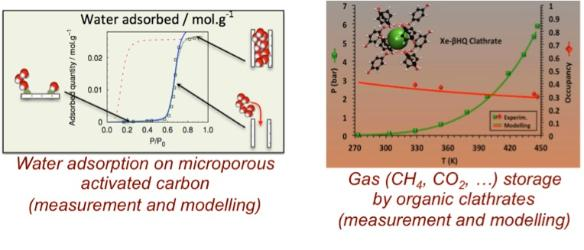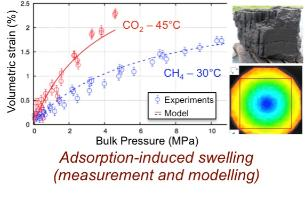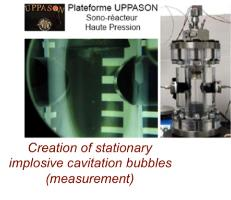G2MPGeomechanics of Porous Media
Presentation of the team
The G2MP (Geomechanics / Porous media) group, spearheaded by David GREGOIRE, focuses on the mechanical behavior of porous media, fluid-solid couplings and the general transport properties in these media. The group develops both experimental characterization and modeling activities using digital simulation tools at different scales.
Its current activities focus essentially on:
- Understanding fluid behavior in microporous networks.
- Poro-mechanical modeling of micro- and meso-porous media and the transition from the nano-scale to continuum mechanics.
- Understanding relations and couplings between permeability and damage.
Research activities
Understanding fluid behavior in microporous networks.
This involves developing models of fluid behavior in porous media for where the extreme confinement significantly modifies the thermodynamic properties. Several lines of research are pursued, including the complexity of adsorbed fluids (water, electrolytes, gas mixtures, etc.) or refining the description of pore geometry. The approach followed by the team is that of continuum models such as density functional theory (DFT) combined with high-performance equations of state (e.g. SAFT). Validation using molecular simulation on simple configurations is one of the areas we are working on with the other teams in the laboratory.
Experimental techniques that help characterize this phenomenon are also developed over extensive temperature and pressure ranges, including the induced energy effects and tackling the issues related to selective adsorption (vapors, water-hydrocarbon mixtures) more systematically. The decontamination of pollutants (including Metal Trace Elements, such as mercury or aromatics) present in storage gases and the synthesis of nanomaterials for decontamination are also some of the target applications.
In parallel, new applications can also be found for these characterization methods and associated models. The development of new porosimetry methods by adsorption is envisaged by using measurements taken on larger pressure and temperature ranges, using probe molecules that can display phase transitions in the investigated conditions.
The focus work undertaken over the last few years in the field of thermodiffusion applied to the characterization of the distribution of chemical species in reservoirs is on the study of ternary mixtures in critical conditions and very low-permeability porous media. Molecular dynamics have shown separations owing to the Soret effect that are not conform to the predictions of standard models for pore diameters less than five times the molecular diameter. These results must therefore be confirmed through experimental observations and understand the effects induced by fluid confinement.
Poro-mechanical modeling of micro- and meso-porous media and the transition from the nano-scale to continuum mechanics.
This challenge covers modeling the expansion related to adsorption in these media and the temporal behavior (creep) of the same materials according to pore size. In the first case, the impact of the fluid on the deformation of the solid is quantified by determining the changes in fluid pressure owing to confinement before drafting a combined adsorption/expansion theory. This theory assumes an improved understanding of surface effects on the behavior of microporous media. In the case of creep in microporous materials, the aim is to determine the effect induced by the presence of the fluid confined in a microstructural assembly where sliding between solid particles, thought to be the origin of creep, is possible. The understanding of these phenomena is based on results of molecular simulation in model configurations. The final objective is to establish a relation between fissuring (and therefore damage) and to introduce non-linear material effects into models which are currently elastic.
Understanding relations and couplings between permeability and damage
When micro-fissuring develops in the solid phase of the porous medium, under the effect of a mechanical load, the permeability increases because the porous network has been modified. The aim is to establish links between the mechanical load applied, the development of micro-fissuring and the evolution in the permeability of the medium. As regards the non-linear behavior of the solid phase, the use of discrete (lattice) models is the preferred method. The challenges are to understand the organization of the rupture process by micro-fissuring and localization, the comparison with acoustic emission data and the transition to 3D.
Use of the discrete model is generalized by introducing the coupling between damage and permeability at a local level (lattice elements). The consideration of saturation in the porous medium (fluid mixture, relative permeability, capillary bore phenomena, etc.) and phase changes in the fluid part (liquid-vapor) are broached in this context. The target applications are fracturing induced by the fluid phase (static and/or dynamic), qualifying the tightness of solid bedrock and/or confinement walls, but also the simulation and understanding of the geological history by comparison with observation data, in collaboration with our geologist colleagues in the laboratory.
Development of a high-pressure sonoreactor / study of cavitation generated by ultrasound waves.
The use of cavitation generated by high-power ultrasound waves is very interesting for both fundamental research and for its use in industrial processes. Many sectors such as the agro-food, medical and pharmaceutical industry already extensively use this technique in sonoreactors. In this context, an experimental platform - UPPASON - has been developed. In the long term, this high-power ultrasound sonoreactor device, working under high pressure, should enable a fine phenomenological analysis and quantitative measurements, through the combined use of calorimetry, acoustic and optic spectroscopy, gas chromatography or the measurement of electrical conductivity.




